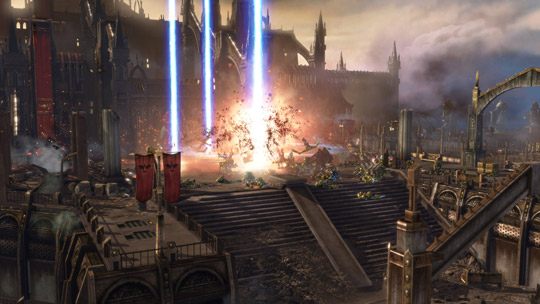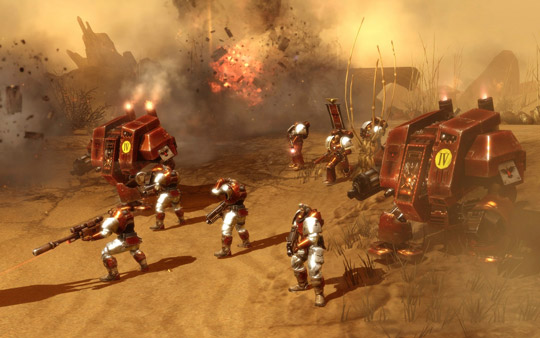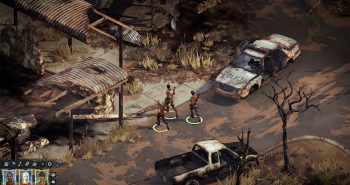
When we saw Warhammer 40k: Dawn of War II at this year’s CES, we learned from Relic’s Johnny Ebbert that the game would take the ‘best’ elements from the first game such as ‘brutal melee combat’ along with features from their Company of Heroes RTS such as unit cover. Well, this is true. However after starting on the game’s campaign mode, what we did not know is that base building is not just cut-back, but really gone altogether. Imagine our shock! Not to be denied our Dawn of War II fix we pressed on past this point of shock and found a much deeper experience within.
Dawn of War II’s campaign mode takes the player(s) by the hand for a short while, introducing characters as well as gameplay tactics and then let’s them loose on three different worlds where they have a ton of free reign over which missions they take and how far along the actual storyline they progress. This open-world campaign mode adds a ton to the game’s replayability, as does the campaign’s character development. Character development in an RTS? Well, yeah!
In the campaign, you will eventually have six squads to command, however you may only chose four to take on your per mission. As an aside, I think the number of troops in each of your squads feels a bit low, but I digress. As you play missions, your squad leaders (and hence their squads) will gain experience points that go towards increasing their levels. When a new level is reached, the player can reward these team leaders by placing an additional two attribute points in any of the following categories: Health, Ranged Combat, Melee Combat, and Energy. Every additional point into one of these categories will help give the squad’s attribute modifiers in the appropriate way, however when certain places along the attribute bars are reached the squad will gain additional ‘traits’ with which to use on the battlefield. For instance, the stealthy scout squad can gain the ability to use up no energy while standing still and cloaked. The attribute points you distribute really decide how your character fights and what its role should be. Don’t go buffing your tactical squad with full melee points if you are planning on equipping them with bolters and havig them plink at the enemy from range.

Also, sometimes when killing a mob, you will find that it dropped a special item, armor, or weapon. Click on this item to pick it up and you can find it in your squad’s joint inventory at the start of the next mission. These items can be mixed and matched between your squads to fully-customize how your units fight. From maces to plasma weapons, you will find it in the game. After all, a big part of Warhammer 40k’s combat is the mixing and matching of melee and ranged weapons. Seeing a force commander shoot at Orks with his pistol before going in for a giblet-filled kill with a chainsword.
This action-RPG style of character development is further enhanced by the bantering of your characters as well as other NPCs in-between missions while setting up the next one to come. Each squad leader’s personalities really emerge and since you only have a finite number of squads, there is a high-level of responsibility you feel for them. You end up really caring about keeping these guys alive and bringing everyone home.
Along the way, you will fight not only the Orks but also the advanced Eldar and insectoid Tyranids, which serve up some of the game’s most awesome and intense moments. Let’s just say Tyranids never fight alone….Actually, there always seems to be hundreds of them, so use that cover well. Getting a handle on the game’s cover system is key to being successful at the missions. A covered squad is worth the equivalent of three uncovered ones. Whats more, you will have to think quickly in order to stay covered and out-flank your enemies before they out-flank you.

Visuals in Dawn of War II are beautiful, with incredibly detailed particle effects. This is nowhere better seen than in the game’s explosions. The presentation of the visuals is also very important. Heavy ordinance shakes the ground and created massive fireballs and plumes of smoke. The camera is fairly versatile and makes zooming into watch your troops dismember the enemy a ton of fun.
With all the stuff going on, it is a wonder you can discern any sound apart from another. The sound design in the game is exceptional and manages to capture all of the nuances of the game’s combat without getting muddled down. The voice actors a fine job of bringing their characters to life and never sound wooden or take you out of the experience.
The game’s skirmish modes seem like more of a nod to the RTS fans, but even then the actual base-building is really not there. Instead, you capture points a la Company of Heroes which adds to your power and renown, then spending these attributes to create or upgrade units.
I am one of those RTS fans that does not like ‘zerging’. I like a ‘good’ RTS match where players have a bit of time to build up their bases/defenses and get some real armies made with which to battle against each other. I would not normally like a game such as Dawn of War II because of its focus on keeping the action moving all the time. However, due to it not feeling much like an RTS, the lack of base-building and flow of combat did not phase me in the least.

That being said, Dawn of War II is not a real-time strategy game. It is a hybrid between an RTS, action-RPG, tactical shooter, and hack ‘n slash game. This combination is masterfully put together by Relic and they are to be commended for actually doing something original. Sure, a tried and true RTS sequel would have been great too, but this is not just great. Warhammer 40k: Dawn of War II also pushes the bounds of multiple genres in a very clever way and that masterful originality can mean the difference between a game you play for a week and a game you find yourself wanting to play a year later.




